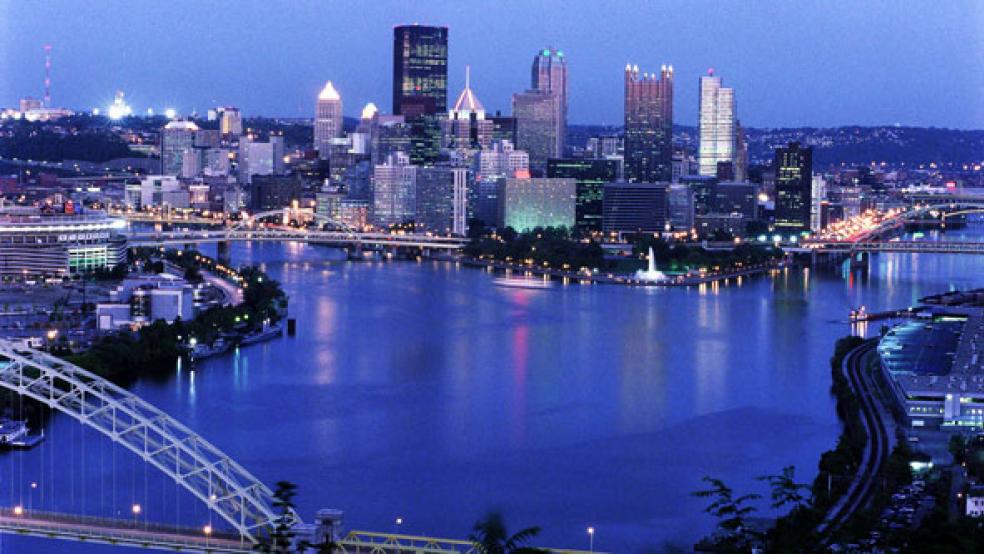Rust – that gritty sign of obsolescence – has over the past few decades seemed the perfect metaphor for the swath of the United States that was once a manufacturing juggernaut. Even during the past decade, America's Rust Belt has been written off as a junkyard, victim to the changing American economy and the outsourcing of manufacturing. Populations declined by as much as half over half a century, poverty rates rose, houses stood empty, and everyone gazed longingly at the exploding Sun Belt to the south and west.
That was before the Great Recession. Now, in defiance of the economic crisis that has wreaked havoc across the country, many Rust Belt cities are showing signs of a rebound. A combination of factors, including long-term planning and changes wrought by the recession, are playing a part in the incipient revival of cities like Pittsburgh, Buffalo, Indianapolis, Baltimore, and Milwaukee. That isn't to say the problems are over for the Rust Belt – Cleveland and Detroit in particular continue to struggle – but there are reasons to believe many once-derided municipalities are finally on a sustainable new track.
Reversing the Brain Drain
During the high-flying years of the 1990s and early-2000s, the highly educated were pouring into tech hubs (San Jose and Boston), quality-of-life capitals (Portland and Austin), and centers of rapid growth (Las Vegas and Phoenix). Rust Belt cities were bleeding brainpower.
Then the housing bubble burst. Suddenly, those with newly minted diplomas weren't so eager to fly the coop. A report released this year by William Frey of the Brookings Institution documents the change – Pittsburgh, Columbus, and Baltimore all saw gains in migration of college-educated adults between 2007 and 2009, while Buffalo and Cleveland stemmed the outward migration. The shift, Richard Florida observed in The Atlantic, “put older Rust Belt metros back on the talent map.”
New Industries, New Jobs
Rust Belt cities now offer those educated workers a more attractive job market for their skills. As far back as 30 years ago, some cities began efforts to diversify their economies beyond the manufacturing base. Decades later, those efforts seem finally to paying off. Pittsburgh offers the most dramatic example. “Over the long term, certainly Pittsburgh has become transformed from a place that was extremely dependent on the steel industry to a place that now is much more dependent on health care and education,” says Howard Wial, a fellow at the Brookings Institution's Metropolitan Policy Program. Today, education and health services account for about 21 percent of Pittsburgh's total nonfarm jobs, compared with 16 percent for manufacturing, according to data from the Bureau of Labor Statistics. The city's largest employer is now UPMC, a health-care conglomerate that as of 2010 employed almost 37,000 people locally.
Other Rust Belt cities have begun to mirror this example. In Buffalo, it's health care, IT, and financial services. In Baltimore, financial services have been added to a mix that already includes education and medicine. In Buffalo, manufacturing now accounts for just 9 percent of jobs, while in Baltimore, it accounts for just 5 percent.
Manufacturing Recovery
While diversifying has been key, most Rust Belt cities still rely to some degree on manufacturing. And even there, positives can be found. “Generally speaking, nationwide, manufacturers have become more competitive in terms of cost and productivity in the aftermath of the recession,” says Arijit Dutta, senior economist at Moody's Analytics. “U.S. manufacturing is actually quite competitive at this point.”
Dutta adds that U.S. companies are now more eager to maintain a domestic base, avoiding the supply-chain vulnerabilities common in the globalized economy, and they are finding unions more amenable to negotiations than before. In cities reliant on auto or auto-parts manufacturing, the recovery has been particularly strong, according to both Wial and Dutta – good news for the Rust Belt.
Armen Bedroussian, senior economist at the Milken Institute, notes that successful Rust Belt cities have shown an ability to adapt. “It's not so much getting entirely rid of what you have. You can actually transform the old stuff into new technologies.” Bedroussian cites green technologies as a proven example.
Housing: No Bubble, No Bust
While the rest of the country clamored to get a piece of booming housing markets, Rust Belt cities watched from the sidelines. “There wasn't a bubble in any of these places to speak of, with the possible exception of Baltimore,” says Wial.
And since it never went up, it didn't come down. In fact, according to data from the National Association of Realtors, median home prices in Buffalo increased over 22 percent between 2006 and 2010, during the heart of the housing bust. In Pittsburgh, they're up over 5 percent, and in Indianapolis, 3.6 percent. This stability helped these cities avoid the dramatic ripple effect from the housing bust that afflicted other regions.
Jobs and Growth
Unemployment in Buffalo, Syracuse, Pittsburgh, Cleveland, Erie, and Milwaukee is safely below the national average of 9 percent. The country's metropolitan economies overall saw GDP growth of 2.5 percent last year, according to the Bureau of Economic Statistics. But Pittsburgh's GDP grew 4.1 percent, Buffalo's 3 percent, Baltimore's 3.3 percent, and Indianapolis' 3.6 percent. And while job growth has been dismal nationwide, it is better than average in many of the Rust Belt cities.
Still, there's more to be done. “[The transition] is still not happening to the extent that it needs to … It's hard to fill a void that big,” says Dutta. “Rust Belt cities need to better market themselves going forward. Some have already begun to do so.” The rust, then, hasn't all been scraped away, but there are undeniable glimmers of promise.




